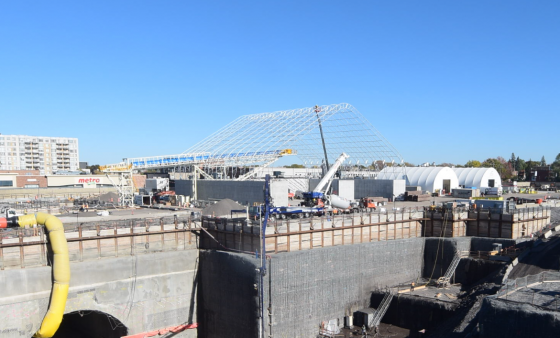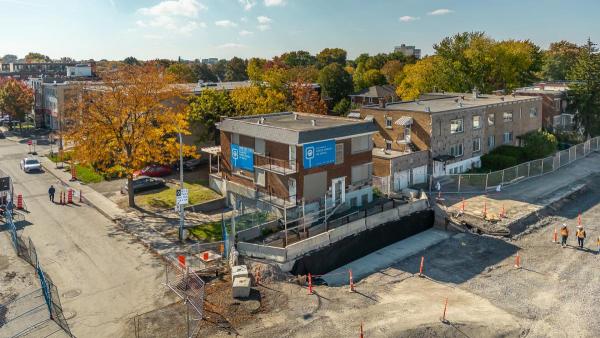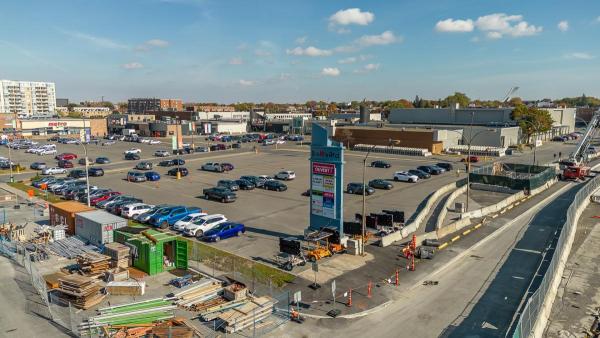Construction of the Vertières station (Pie-IX)
The Blue line extension reaches two major milestones
For the past year, work on the Blue line extension has been progressing steadily, on schedule. Key milestones have recently been reached, marking tangible progress on the ground.
1.Excavation is now complete at the Vertières and Madeleine-Parent stations
2.The tunnel boring machine for the Blue line extension has finally arrived
Learn more about reaching these two important milestones for the Blue line Project.
- Construction site summary
- Impact on customer trips
- Impact on local residents
- Learn more about the project
- Onglet 5
Construction site summary
As part of the Blue line project, this worksite involves building a new accessible métro station with two entrance buildings on each side of Pie-IX Boulevard, and a bus terminal. The entire extension is expected to be commissioned in 2031.
Description of the work: Construction of new surface-level and underground infrastructure.
Next steps: The excavation phase on the site of the main access building to the station has now been completed. Roadheaders work continues on the horizontal excavation of the tunnels. Construction of the secondary access to the station is expected to begin in the fall of 2026, west of Pie-IX Boulevard.
A direct link to the Pie-IX Boulevard bus rapid transit (BRT) service
A pedestrian tunnel will provide direct access to the Vertières métro station from the BRT shelters.
This pedestrian tunnel was built as part of the integrated Pie-IX BRT project, which required the temporary closure of Pie-IX Boulevard . This strategy allowed us to limit traffic disruptions in the area and avoid affecting BRT service after it was inaugurated.
Learn more about the pedestrian tunnel (French only)
Impact on customer trips
Since the contractor began work on the site in fall 2024, bus stops for lines 141, 188 and 372 between Pie-IX and Provencher have been relocated. Westbound stops are moved to Everett, and eastbound stops are moved to Bélanger.
Impact on local residents
Work is currently underway east of Pie-IX Boulevard, on the station’s main access site. Work west of Pie-IX Boulevard is expected to begin in the fall of 2026.
This is a key worksite for the Blue line extension, as it is where the tunnel boring machine will begin digging the métro tunnel and where all the excavated material will be removed.

IMPACT OF WORK
![]()
- Jean-Talon is completely closed to traffic between Pie-IX and 24th Avenue.
- 23rd and 24th Avenues are now dead ends and have been set up for two-way traffic. Some parking spaces have been removed to allow for this configuration.
![]()
- The north sidewalk on Jean-Talon remains open to allow east-west foot traffic.
- The south sidewalk is blocked due to the worksite.
- Flaggers are present at worksite entrances and exits for pedestrian safety.
- Stay alert, only cross the street at traffic lights and crosswalks, and follow all instructions from the worksite crews.
A temporary structure under construction
Vertières station site will be the entry point for the tunnel boring machine, which will excavate most of the tunnel to the future Anjou station. It will also be the exit point for the rock excavated during work in the tunnel.
A shelter is currently being built on the site, in order to store the rock until it is transported by truck. This structure will notably reduce noise associated with truck loading. So don't be surprised if you see this imposing structure when passing by !
Good to know :
- Access to homes and businesses will be maintained at all times.
- Signage will be posted to direct pedestrians, cyclists and drivers.
- Worksite trucks will be circulating on Pie-IX, Jean-Talon and Provencher.
- To reduce the negative impact on local residents, we will implement specific mitigation measures. This will include installing noise walls around the worksite perimeter.
Join your local good neighbour committee!
Do you live near the future Vertières station or Provencher auxiliary building and want to have your say in how these worksites will fit into your neighbourhood?
Write to us to apply or to find out more.
Learn more about the project
parlons·en
Public participation
Information sessions, talks, activities, good neighbour committees: our team wants to meet you!
Questions and answers
In the coming months, we’ll be starting excavation work to make way for new infrastructure for the Blue line project .
The excavation method will vary depending on the type of work being done. The surface excavation work will involve controlled microblasting, whereas most of the excavation for the underground tunnel will be done using a tunnel boring machine, or TBM. At both types of worksites, there will also be some mechanical excavation. The vibrations produced by the different excavation methods will be measured on an ongoing basis using seismographs. These devices will be installed at various points throughout the excavation zones and will be used to continuously monitor the vibration levels and make sure they fall within legal limits.
Essential preventive measures
To prepare for upcoming excavation work, the STM has tasked ABS with inspecting buildings that meet at least one of the following criteria:
• Located within 75 metres of any surface-level excavation work
• Located within 30 metres of the tunnel axis
The inspections will serve to compile an inventory of the structures surrounding the worksites for the Blueline project. The findings of the inspections will also be used to establish the maximum vibration levels for each site. Although these inspections are a precautionary measure, they are essential in the unlikely event that the work causes any damage.
As a further precaution, any building within 100 metres of a worksite where there will be microblasting will receive a carbon monoxide detector a few weeks before the excavation work starts.
Each building inspection lasts approximately 15 to 30 minutes. Photos are taken of the building interior and exterior. The photos are mostly close-ups of the foundations, walls, ceilings, and floors and serve to document the building’s condition prior to the start of the excavation work.
The pre-construction inspection is a common precautionary measure for major construction sites. It protects you in the unlikely event that your property suffers any damage during work on the Blue line project.
In the fall of 2024 and 2025, urban forestry work will take place around the Blue line project worksites. Trees that interfere with the construction sites will be protected, replanted, or cut down. Our team of forest engineers, landscape architects, urban planners, and sustainable development experts has carefully planned these interventions to preserve as many trees as possible.
The goal is to replant the trees wherever possible. Soverdi, the not-for-profit organization overseeing the replanting process, will monitor and care for the trees after they are transplanted to ensure their survival. Trees that can’t be replanted due to their size or condition will be recycled into wood chips, firewood or compost depending on the quality of the wood. The health and species of the trees will also help determine which ones need to be cut down, based on whether they are diseased, subject to borer infestations, or invasive, among other factors.
Ultimately, Blue line project sites will be revegetated and several hundred new trees planted, for a stronger, healthier canopy. For every tree replanted or cut down, we will plant more than two in their place.
In 2020 and 2021, two archeological potential studies were conducted at the sites of several future structures. This is standard procedure whenever we break ground on a project of this scale that requires excavation. Three future métro stations were identified for targeted interventions, at Pie-IX, Viau and Saint-Michel. These sites were chosen because they are located along the watershed of the Ruisseau du Pont à l’Avoine, a now-dried stream that existed until the 1950s. It flowed south to join the Ruisseau Molson and into the St. Lawrence.
- The sites of the future métro stations at Pie-IX and Viau intersections will be studied as they are likely to show signs of former Indigenous occupation.
- The site of the future Saint-Michel power station, located beside the métro station of the same name, is potentially significant to European Quebec history, since it was occupied more recently in the early 20th century. A delivery company occupied the space until the 1960s, when the building was destroyed by fire.
How are the digs conducted?
An expert archeological firm has been hired to conduct the digs. After analyzing the sites and leading archeological potential studies, the archeologists will choose locations for inventory trenches. The trenches will be roughly one metre deep and will allow the researchers to physically evaluate the site’s potential.
What do you do if there is a find?
If anything is found, the trench where it is discovered will be enlarged, and additional probes will be done to evaluate its archeological features. An inventory is also conducted as needed.
Have you ever found any historical artifacts?
At the site of the future Vertières métro station (Pie-IX), archeologists unearthed a stone wall and a wooden beam. Although these vestiges show that the site was occupied at the beginning of the last century, they were not of significant heritage value. An archaeological inventory was carried out to document the precise location of the ruins. The inventory included a qualitative and quantitative identification, ensuring the protection and safeguarding of the vestiges’ data.

Yes, the shopping centre will be able to remain in operation during the expected construction period of the new Vertières station. However, it will be partially deconstructed to prevent any interference with worksite or shopping centre operations.
The STM acquired the building on December 1, 2021, following the expropriation process started earlier in the project timeline.
The property will be managed by STM subsidiary Transgesco. A recognized company specializing in this area has also been mandated to manage shopping centre operations.
More about the Blue line project
Contenu de l'onglet 5
Stay informed
Stay informed of the project’s progress and other events by signing up for the electronic newsletter.
The project in images
The Blue line project follows in the wake of the Déclaration du gouvernement du Québec et de la Ville de Montréal to revitalize Montréal East. Many projects are underway to give a new impetus to this sector. Increased mobility, economic development, and improved living environments are at the heart of this ambitious project. For more information, see Québec.ca/RevitalisationEstMontreal (in French only).









